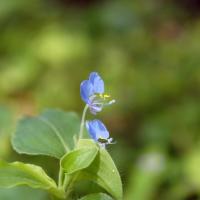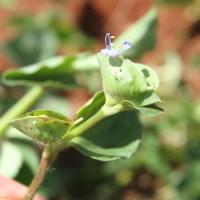Benghal dayflower
Commelina benghalensis
Commelina benghalensis, commonly known as Benghal dayflower, tropical spiderwort, or wandering Jew, is a perennial herbaceous plant in the Commelinaceae family. Native to tropical and subtropical regions of Asia, it has become naturalized in various parts of the world. Here are key features and information about Commelina benghalensis:
-
Plant Type:
- Perennial Herb: Benghal dayflower is a perennial plant, meaning it can live for more than two years.
-
Habitat and Distribution:
- Native Range: The species is native to tropical and subtropical regions of Asia.
- Global Distribution: It has become naturalized in many tropical and subtropical areas, including Africa, the Americas, and Australia.
- Habitat: Benghal dayflower thrives in a variety of habitats, including disturbed areas, agricultural fields, gardens, and along waterways.
-
Growth Characteristics:
- Low-Growing and Creeping: The plant typically grows low to the ground and can spread horizontally with creeping stems.
- Reproduces Vegetatively: It can reproduce both by seed and vegetatively from nodes along its creeping stems.
-
Leaves:
- Alternate Arrangement: The leaves are arranged alternately along the stems.
- Ovate to Lanceolate: Leaves are typically ovate to lanceolate in shape with a pointed tip.
-
Flowers:
- Distinctive Blue Flowers: Benghal dayflower is known for its striking blue flowers, which have three petals.
- Inflorescence: The flowers are borne in clusters or spikes and have a short life span, often opening in the morning and closing by afternoon.
-
Reproductive Strategy:
- Seed Production: The plant produces seeds that are dispersed by water, animals, or human activities.
- Vegetative Propagation: It can also propagate vegetatively from stem fragments that root at nodes when in contact with soil.
-
Ecological Role:
- Competes with Crops: In agricultural settings, Benghal dayflower is considered a weed and can compete with crops for nutrients and space.
- Tolerant of Disturbed Areas: Its ability to thrive in disturbed habitats contributes to its weedy nature.
-
Control Measures:
- Cultural Practices: Crop rotation, proper irrigation, and maintaining weed-free conditions are some cultural practices used to control Benghal dayflower in agriculture.
- Herbicide Application: In some cases, herbicides may be used to control the growth of this weed.
-
Ethnobotanical Uses:
- Traditional Medicine: In some traditional medicine systems, extracts from Benghal dayflower have been used for various medicinal purposes. However, caution is needed due to its weedy and potentially invasive nature.
-
Invasive Potential:
- Invasive Traits: Benghal dayflower can exhibit invasive tendencies in certain environments, particularly in disturbed or agricultural areas.
Understanding the growth habits, ecological impact, and control measures associated with Benghal dayflower is essential for managing its presence in agricultural settings and preserving the integrity of native ecosystems.




















Plant Protection Products
- ⭑⭑⭑
- ⭑⭑⭑
- N/A
- ⭑⭑⭑
- ⭑⭑⭑
- ⭑⭑
- N/A
- ⭑⭑⭑
- ⭑⭑⭑
- N/A
- N/A
- N/A
- ⭑⭑⭑
- N/A
- N/A
- N/A
- N/A
- N/A